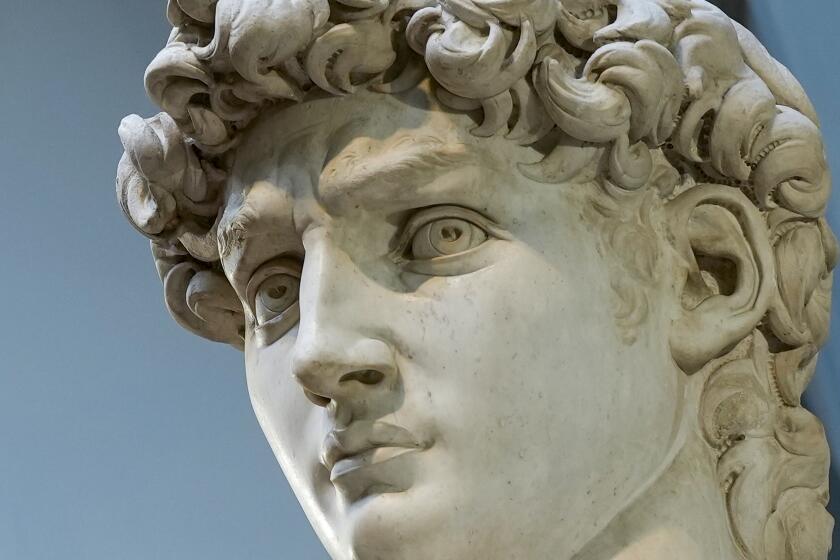‘Whiteness’ Exhibit an Exercise in Identity
The first thing you notice upon entering the main gallery of the Laguna Art Museum is the pervasiveness of white. The second thing is that what we’re talking about here isn’t just paint.
“Whiteness, a Wayward Construction,” museum officials say, is the first art exhibit to their knowledge that explores being white in America. And though no angry protesters have gathered at their gates, they say the subject has inspired some passionate debate.
“Until now,” says Tyler Stallings, 37, the museum’s curator of exhibitions who shepherded the show, “it was only talked about in academia.”
It’s no accident, of course, that such an event would premiere in Orange County. For much of its history, the area once dotted with citrus groves was a bastion of white Republicanism. And at its heart was Laguna Beach, wealthiest of the wealthy and whitest of the white.
All that has changed. Today, among the county’s residents are large numbers of Asians, Latinos, Middle Easterners and African Americans. And, as elsewhere in the state, white people once constituting the unchallenged majority now find themselves, in many areas, in the minority.
Enter into this caldron Stallings, a self-admitted white boy from Kentucky. He got the idea for the whiteness exhibit, he says, from a 1998 article in Artform magazine called “The White Stuff” that explored the sudden plethora of books on the subject. If writers could focus on whiteness, Stallings decided, why couldn’t artists?
As his research deepened, however, a theme began to emerge; namely that, in some quarters, whiteness had become more of an idea than a description of race.
“It’s a doctrine of beliefs having more to do with power than with color,” Stallings says. “Whiteness is a recognition involving privilege and wealth.”
He cites two examples. First, he says, is the genetic research conducted by scientists increasingly holding that there is no “pure race” -- that the human gene pool has become so intermingled that what we have traditionally referred to as racial identity is really just a point on a continuum.
And second, Stallings points to the 2000 census in which participants, for the first time, were allowed to identify themselves as members of more than one race. According to a recent newspaper article, he says, Latinos living in affluent, suburban parts of Los Angeles tended to identify themselves as white, while those living in the city’s urban barrios selected other racial or ethnic categories. In other words, he says, whiteness was seen more as a symbol of economic status than a physical description.
“The reality,” Stallings says, “is that there are no white people -- white is just a word.”
That reality may be somewhat reflected among the 30 artists whose work is included in the show, which runs through July 6. Only about half of them, Stallings says, would probably put their Xs in the census box marked “white.” Looking at their art, however, you’d be hard pressed to say just which piece is whose.
There’s a painting of a young white girl boxing with her shadow, and another one consisting entirely of white. A long “spine” is constructed from dozens of white collars. A white plate next to several baby shoes has a small swastika at its center, while nearby hangs the portrait of a hooded member of the Ku Klux Klan. And a stairway going nowhere appears to have been sloshed with white paint from an overflowing bucket at its end.
The art doesn’t speak a universal language.
Richard Johannson, a retired anthropologist from Placentia, saw the show and was so impressed that he made a second trip with his Vietnamese-born wife, Erika, an elementary school teacher. “I thought it would help her in her teaching,” said Johannson, 61, who is white.
Erika Johannson, however, had other ideas.
“It’s more about white people and how they view other cultures,” she pronounced after having a quick look. “It doesn’t speak to me.”
Mervyn Edwards, 63 and white, on vacation from England with his 24-year-old son, said he wasn’t sure he understood the show. “It’s very interesting,” he said, “but there are some things I can’t quite grasp.”
And Doris Winston, 80 and white, visiting from West Los Angeles with a group of volunteers for the Los Angeles County Museum of Art, said the whole thing left her cold. “It’s not my cup of tea,” she said. “I don’t relate to it any way.”
Yet there were those who felt engaged.
Janice Wong, 28, a Cal State Fullerton student born in China, said the exhibit forced her to realize that her own tolerant, diversified world had shielded her from the larger reality.
“It’s the first time I’ve ever been to a museum that talks about race,” she said. “It’s been a while since I’ve thought about that issue, but I guess it’s still there.”
And Eileen Silverstrom, a 74-year-old white woman from West Los Angeles, said she thought she saw the point. “What they’re saying,” she suggested, “is that, underneath the skin color, we’re all the same.”
According to Stallings, there are no right or wrong answers -- like much art, he says, the show is meant to provoke.
“Art can challenge the meaning of things,” he says. “The point is to raise questions that make you think, without being told that you’re wrong.”
And what of his own political agenda?
“It’s about making people who think of themselves as white conscious of what that means,” Stallings says. “It’s about challenging the view that whiteness is invisible.”
More to Read
The biggest entertainment stories
Get our big stories about Hollywood, film, television, music, arts, culture and more right in your inbox as soon as they publish.
You may occasionally receive promotional content from the Los Angeles Times.






